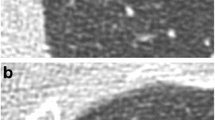Abstract
Purpose
Micro computed tomography (micro-CT) can provide detailed information about the internal structure of materials. This study aimed to demonstrate the diagnostic value of micro-CT in formalin fixed paraffin embedded pulmonary adenocarcinomas by correlating the micro-CT findings of tumoral and non-tumoral areas with hematoxylin and eosin (HE) sections.
Methods
Paraffin blocks obtained from three adenocarcinomas were scanned with micro-CT. Ten regions of interest (ROIs) from adenocarcinoma and 11 ROIs from pulmonary parenchyma (ROI-C and ROI-N, respectively) areas were compared regarding the various structural parameters.
Results
All parameters were significantly different regarding the tumoral and non-tumoral ROIs. The percent object volume, structure thickness, structure linear density, connectivity and connectivity density were higher in ROI-Cs (p < 0.000, p < 0.000, p = 0.001, p < 0.000, and p < 0.000 respectively); whereas intersection surface and structure model index were higher in ROI-Ns (p < 0.000 and p < 0.000). The open porosity percentage was higher in ROI-Ns (68.86 + 2.96 vs 48.29 + 5.11, p < 0.000) and the closed porosity percentage was higher in ROI-Cs (2.29 + 0.55 vs 0.57 + 0.17 p < 0.000).
Conclusions
The tumoral and non-tumoral areas in paraffin blocks can be distinguished from each other, using the quantitative and qualitative information obtained by micro-CT. Making this distinction with quantitative data obtained from micro-CT can therefore be the basis of creating artificial intelligence algorithms in the future.



Similar content being viewed by others
Abbreviations
- CT:
-
Computed tomography
- LC:
-
Lung cancer
- SD:
-
Standard deviation
- Min–max:
-
Minimum–maximum
- Micro-CT:
-
Micro computed tomography
- 3D:
-
Three dimensional
- HE:
-
Hematoxylin and eosin
- FFPE:
-
Formalin fixed and paraffin embedded
- ROI:
-
Region of interest
- ROI-C:
-
ROI-carcinoma
- ROI-N:
-
ROI- non-tumoral pulmonary parenchyma
- OV/TV:
-
Percent object volume
- TV:
-
Tissue volume
- ST:
-
Structural thickness
- IS:
-
Intersection surface
- SMI:
-
Structure model index
- SLD:
-
Structure linear density
- Cn:
-
Connectivity
- CnD:
-
Connectivity density
- WSI:
-
Whole slide imaging
References
Bray F, Ferlay J, Soerjomataram I, Siegel RL, Torre LA, Jemal A. Global cancer statistics 2018: GLOBOCAN estimates of incidence and mortality worldwide for 36 cancers in 185 countries. CA Cancer J Clin. 2018;68(6):394–424. https://doi.org/10.3322/caac.21492.
National Comprehensive Cancer Network. NCCN Clinical practice guidelines in oncology. Non-small cell lung cancer. Version, 2.2020-Dec 23, 2019. 2019 Accessed 03 Feb 2020.
Didkowska J, Wojciechowska U, Mańczuk M, Łobaszewski J. Lung cancer epidemiology: contemporary and future challenges worldwide. Ann Transl Med. 2016;4(8):150. https://doi.org/10.21037/atm.2016.03.11.PMID:27195268;PMCID:PMC4860480.
Xu B, Teplov A, Ibrahim K, Inoue T, Stueben B, Katabi N, et al. Detection and assessment of capsular invasion, vascular invasion and lymph node metastasis volume in thyroid carcinoma using microCT scanning of paraffin tissue blocks (3D whole block imaging): a proof of concept. Mod Pathol. 2020;33(12):2449–57. https://doi.org/10.1038/s41379-020-0605-1.
Wang S, Yang DM, Rong R, Zhan X, Xiao G. Pathology image analysis using segmentation deep learning algorithms. Am J Pathol. 2019;189(9):1686–98. https://doi.org/10.1016/j.ajpath.2019.05.007 ((Epub 2019 Jun 11. PMID: 31199919; PMCID: PMC6723214)).
Orhan K, Jacobs R, Celikten B, Huang Y, de FariaVasconcelos K, Nicolielo LFP, et al. Evaluation of threshold values for root canal filling voids in micro-CT and nano-CT images. Scanning. 2018;2018:9437569. https://doi.org/10.1155/2018/9437569.
Guldberg RE, Ballock RT, Boyan BD, Duvall CL, Lin AS, Nagaraja S, et al. Analyzing bone, blood vessels, and biomaterials with microcomputed tomography. IEEE Eng Med Biol Mag. 2003;22(5):77–83. https://doi.org/10.1109/memb.2003.1256276.
Orhan K. Micro-computed Tomography (micro-CT) in Medicine and Engineering, Springer 2020
Shearer T, Bradley RS, Hidalgo-Bastida LA, Sherratt MJ, Cartmell SH. Three-dimensional visualisation of soft biological structures by X-ray computed microtomography. J Cell Sci. 2016;129(13):2483–92. https://doi.org/10.1242/jcs.179077.
Descamps E, Sochacka A, de Kegel B, Van Loo D, Hoorebeke L, Adriaens D. Soft tissue discrimination with contrast agents using micro-ct scanning. Belgian J Zool. 2014;144(1):20–40. https://doi.org/10.26496/bjz.2014.63.
Kampschulte M, Schneider CR, Litzlbauer HD, Tscholl D, Schneider C, Zeiner C, et al. Quantitative 3D Micro-CT imaging of human lung tissue. FortschrRöntgenstr. 2013;185:869–76. https://doi.org/10.1055/s-0033-1350105.
Cavanaugh D, Johnson E, Price RE, Kurie J, Travis EL, Cody DD. In vivo respiratory-gated micro-CT imaging in small-animal oncology models. Mol Imaging. 2004;3(1):55–62. https://doi.org/10.1162/153535004773861723 (PMID: 15142412).
Farahani Navid, Braun Alex, Jutt Dylan, Huffman Todd, Reder Nick, Liu Zheng, et al. Three-dimensional imaging and scanning: current and future applications for pathology. J Pathol Inform. 2017;8:36. https://doi.org/10.4103/jpi.jpi_32_17.
Senter-Zapata M, Patel K, Bautista PA, Griffin M, Michaelson J, Yagi Y. The role of micro-CT in 3D histology imaging. Pathobiology. 2016;83:140–7. https://doi.org/10.1159/000442387.
Bilezikian JP. The parathyroids basic and clinical concepts book. 3rd ed. USA: Elsevier; 2015. p. 881.
Mishaela R, Rubin MD, John P, Bilezikian MD. Anabolic therapy of osteoporosis in women and in men. In: Legato MJ, editor. Principles of gender-specific medicine. California: Elsevier Academic Press; 2004. p. 995–1009 ((Chapter 92)).
Ganeshan B, Miles KA. Quantifying tumour heterogeneity with CT. Cancer Imaging. 2013;13(1):140–9. https://doi.org/10.1102/1470-7330.2013.0015 (PMID:23545171;PMCID:PMC3613789).
Miles KA, Ganeshan B, Hayball MP. CT texture analysis using the filtration-histogram method: what do the measurements mean? Cancer Imaging. 2013;13(3):400–6. https://doi.org/10.1102/1470-7330.2013.9045 (PMID:24061266;PMCID:PMC3781643).
Wang X, Sun W, Liang H, Mao X, Lu Z. Radiomics signatures of computed tomography imaging for predicting risk categorization and clinical stage of thymomas. Biomed Res Int. 2019;28:3616852. https://doi.org/10.1155/2019/3616852.
Funding
This research did not receive any specific grant from funding agencies in the public, commercial, or not-for-profit sectors.
Author information
Authors and Affiliations
Corresponding author
Ethics declarations
Conflict of interest
None.
Additional information
Publisher's Note
Springer Nature remains neutral with regard to jurisdictional claims in published maps and institutional affiliations.
Supplementary Information
Below is the link to the electronic supplementary material.
Rights and permissions
About this article
Cite this article
Kayı Cangır, A., Dizbay Sak, S., Güneş, G. et al. Differentiation of benign and malignant regions in paraffin embedded tissue blocks of pulmonary adenocarcinoma using micro CT scanning of paraffin tissue blocks: a pilot study for method validation. Surg Today 51, 1594–1601 (2021). https://doi.org/10.1007/s00595-021-02252-2
Received:
Accepted:
Published:
Issue Date:
DOI: https://doi.org/10.1007/s00595-021-02252-2




